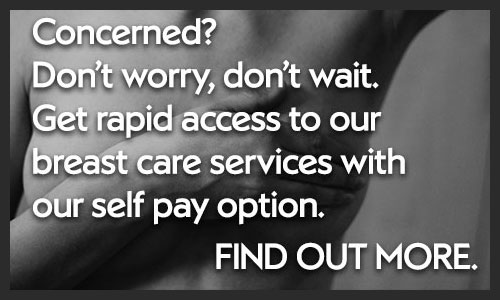How to check your breasts
- Overview
Breast cancer is the most common cancer in the UK with almost 50,000 women diagnosed each year and around 11,500 deaths as a result of breast cancer. But more women than ever are surviving breast cancer as advances in medicine and awareness are increasing. As with all cancers, the faster breast cancer is diagnosed, the less likely it is to spread and the more chance you have of quickly getting back to living the life you love.
Breast cancer can occur at any stage in a woman’s life cycle, so it is important that whatever age you are, you check your breasts regularly (once a month or so) so that you can monitor any changes.
What should you look for?
It’s not just lumps that you should be checking for. There are several other indicators of breast cancer that you can look out for too. Get in touch with your doctor if you notice one or a combination of the following changes in your breast:
- Dimpling, puckering, or bulging of the skin
- Redness, soreness, rash, or swelling
- A nipple that has changed position
- An inverted nipple (pushed inward instead of sticking out)
- Clear or bloody fluid leaking from the nipple
How to perform a breast check
Step 1 - Look
Begin by looking at your breasts in the mirror with your shoulders straight and your arms on your hips.
Here's what you should see:
- Breasts that are their usual size, shape, and colour
- Breasts that are evenly shaped without visible distortion or swelling
But if you see any of the following changes, bring them to your doctor's attention:
- Dimpling, puckering, or bulging of the skin
- A nipple that has changed position or an inverted nipple (pushed inward instead of sticking out)
- Redness, soreness, rash, or swelling
Step 2 - Raise your arms
Look again at your breasts with your raise your arms above your head and look for the same changes.
Step 3 - Lean forward
Now, lean forward so that there is a pendulum affect in your breasts, look for any dimpling, puckering or bulging of the skin.
Step 4 - Fluids?
While you're at the mirror, look for any signs of fluid coming out of one or both nipples (this could be a watery, milky, or yellow fluid or blood).
Step 5 - Feel lying down
Next, feel your breasts while lying down, using your right hand to feel your left breast and then your left hand to feel your right breast.
Use a firm, smooth touch with the first three finger pads of your hand, keeping the fingers flat and together. Use a circular motion, about the size of a 2p coin. Check the entire breast from top to bottom, side to side — from your collarbone to the top of your abdomen, and from your armpit to your cleavage.
Follow a pattern to be sure that you cover the whole breast. You can begin at the nipple, moving in larger and larger circles until you reach the outer edge of the breast. You can also move your fingers up and down vertically, in rows, as if you were mowing a lawn. This up-and-down approach seems to work best for most women.
Be sure to feel all the tissue from the front to the back of your breasts: for the skin and tissue just beneath, use light pressure; for tissue in the middle of your breasts use medium pressure; and for the deep tissue in the back use firm pressure.
When you've reached the deep tissue, you should be able to feel down to your rib cage.
Step 6 - Feel standing or sitting
Finally, feel your breasts while you are standing or sitting.
Many women find that the easiest way to feel their breasts is when their skin is wet and slippery, so they like to do this step in the shower. Cover your entire breast, using the same hand movements described in step 4.
What should I do if I find changes in my breasts?
Remember: Don't panic. Most lumps found will be completely normal. All breasts feel different and are naturally lumpy.
But if you do find changes in your breasts, contact your doctor who will listen to your concerns and perform an examination. You have the right to request a female doctor to perform the examination or to have a female nurse present.
What are the usual next steps?
After your examination your doctor will advise you on whether they think you have a cause to be concerned. You may be referred for a scan, which is usually conducted in a breast checking clinic.
There are three kinds of scan you could receive:
Ultrasound
An ultrasound scan uses high frequency sound waves to make an image of inside the body. It is useful to differentiate between solid, air filled and liquid filled structures. So if you have found a lump, an ultrasound should be able to tell if it is one to be concerned about.
Mammogram
A Mammogram is an x-ray of the breast which can detect breast cancer at an early stage. It involves compressing each breast in the x ray machine while pictures are taken. It’s a quick procedure with the whole test taking no more than 15 minutes. Most women will get a normal result but some women need further tests before diagnosis can be made.
MRI (Magnetic Resonance Imaging)
An MRI (Magnetic Resonance Imaging) scanner uses powerful magnetic fields and radio waves to produce detailed pictures of the structures inside your body. It is a particularly useful diagnostic tool to examine soft tissue structures like breasts.
Your doctor may also need to take a biopsy, which is a sample of tissue or cells taken with a special needle to be looked at under a microscope. This helps to determine whether there are cancerous cells in the tissue.
Once you have a diagnosis you may require treatment which will vary depending on the progression of the cancer. Your doctor will take you through the next steps that are appropriate for you, but they could include any of the following:
Surgery
Surgery is an operation to remove part or all of the breast. The type of surgery depends on the size, location and type of breast cancer. Sometimes the cancer itself can be removed (lumpectomy) and sometimes part of the breast has to be removed (partial mastectomy). In some cases all of the breast is removed (total mastectomy).
Chemotherapy
Chemotherapy is where the cancer is treated with drugs. It can be used to cure a cancer, reduce the risk of the cancer returning or to relieve cancer symptoms.
Radiotherapy
Radiotherapy is high energy radiation commonly used to treat cancer. Almost half of the patients with cancer have radiotherapy as part of their treatment.
Adjuvant therapy
Adjuvant therapy is treatment given in addition to the basic care. It may include chemotherapy or more holistic therapies such a massage, aromatherapy.
Contact us about breast screening
Fill in the form below and we'll get back to you within one working day. If it's urgent, you can call us on 0300 123 6200.
Thank you
A member of the team will respond to you soon.
Last updated Monday 2 March 2020
First published on Friday 19 June 2015


